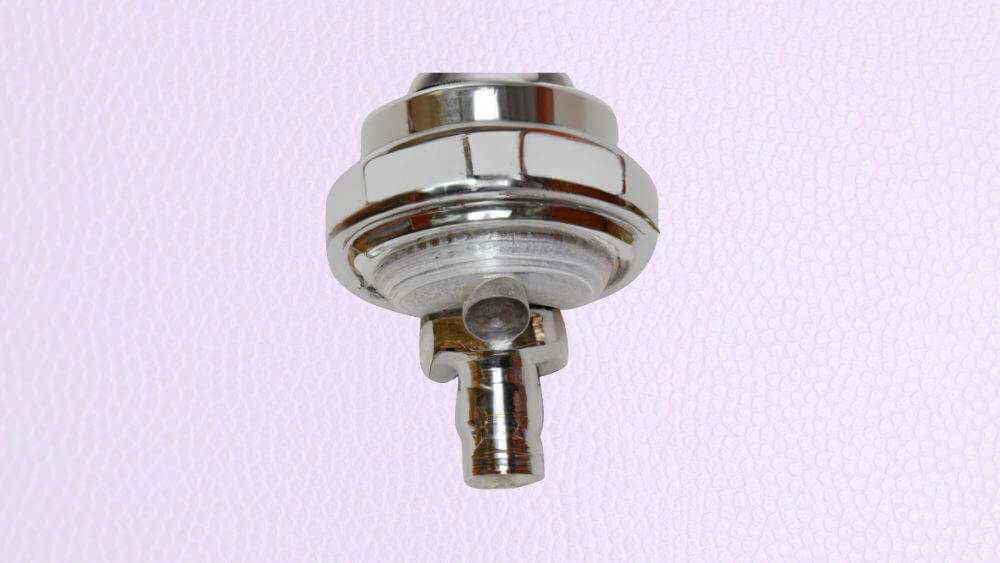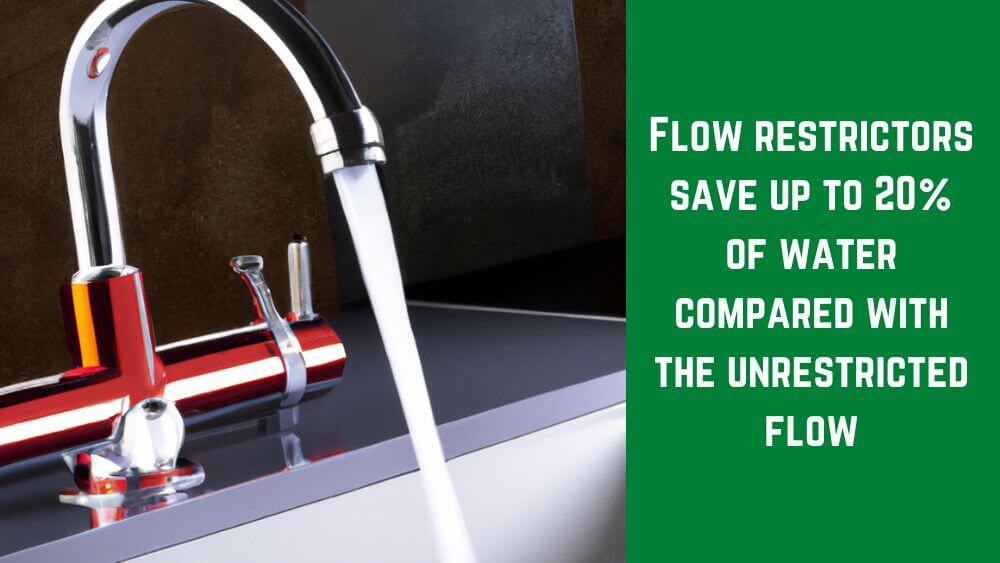Faucets are a staple in any home, but do you know what is inside them? The inner components of a faucet can be confusing, including the flow restrictor. A flow restrictor is a small device installed inside a faucet to limit the amount of water that passes through the nozzle. It is usually made from plastic or rubber, and you can find it in various sizes and shapes.
It is essential for responsible homeowners who want to reduce their water consumption and water bill to understand what a flow restrictor is and how it works. This unique and real-life experience article will provide an in-depth look at a flow restrictor and its pros and cons.
What is a Flow Restrictor?
A flow restrictor is a small device typically installed in faucet aerators and showerheads. This device helps save water by limiting the amount of water from the faucet or showerhead. It is a great way to save on your water bills and reduce water waste.
The flow restrictor on a sink or shower faucet controls how much water flows through the fixture at any given time. It helps prevent waste and save money by reducing the water used in each cycle.
Flow restrictors come in various sizes and shapes and are usually rated by the amount of water they allow to pass through them. Most flow restrictors are removable, making them easy to replace when needed.
Benefits
The purpose of a flow restrictor is to conserve water and maintain more consistent pressure throughout the faucet. The flow restrictor also helps prevent water from leaking into your home. It prevents sudden changes in water pressure that could cause pipes to burst.
Installing a flow restrictor in a faucet provides several benefits:
- It reduces the amount of water used when the faucet is in use. This can help to save on water bills and conserve water.
- It reduces the wear and tear caused by water pressure on the faucet. A well-maintained faucet can last longer and require less maintenance.
- The flow restrictor can help to reduce the noise created by a running faucet, making the kitchen or bathroom more peaceful and comfortable.
How to Identify a Flow Restrictor?
To identify a flow restrictor, look for a small, round, or oval-shaped component with a tiny hole in the center. It is usually rubber or plastic and can be located in the faucet head or the aerator. You will need to unscrew the restrictor to replace it.
How to Remove a Flow Restrictor?
Your faucet’s flow restrictor can become clogged or damaged, reducing water flow. There are a few methods you can use to remove a flow restrictor from your faucet:
- You can use a pair of pliers to remove the flow restrictor from the faucet carefully.
- If the flow restrictor is in a hard-to-reach area, you can use a pair of needle-nose pliers to reach it and twist it off.
- You can use a screwdriver to carefully remove the screw that holds the flow restrictor in place.
- If all else fails, you can call a professional plumber to help you remove the flow restrictor.
How to Replace a Flow Restrictor?
Replacing a flow restrictor in a faucet can be relatively easy if you have the right tools. Just follow the following steps-
- You will need to identify the type of restrictor in your faucet and purchase a replacement that is the same size and shape as the original.
- Use a flathead screwdriver to loosen the screws that hold the restrictor in place. After the screws are removed, use needle-nose pliers to pull the restrictor out of the faucet. Insert the new restrictor and tighten the screws back into place.
- Turn the water on and test the faucet to ensure the new flow restrictor is working properly.
Why Do Faucets Have Flow Restrictors?
Faucets have flow restrictors for many reasons, the most important of which is water conservation. Flow restrictors are designed to reduce the amount of water that comes out of the tap, allowing for more efficient use of water resources.
Additionally, flow restrictors reduce water waste by preventing water from running unnecessarily. Furthermore, flow restrictors can help to reduce water bills by preventing water from needlessly running down the drain.

Do New Faucets Have Flow Restrictors?
Due to EPA requirements, all faucets have been equipped with flow restrictors since 1994. So you do not need to add a flow restrictor to your faucet. If your faucet is purchased before 1994, it might not have a flow restrictor.
Where is the Flow Restrictor in a Kitchen Faucet?
The flow restrictor in a kitchen faucet is typically located in the aerator, which is the end of the spout. It is a small, slim, cylindrical-shaped device typically made of plastic or metal.
When necessary, you can adjust or remove the flow restrictor to limit the water from the faucet. To remove or adjust the flow restrictor, unscrew the aerator, locate the restrictor, and use pliers.
Do Bathtub Faucets Have Flow Restrictors?
Bathtub faucets often have flow restrictors installed, particularly in newer models designed with energy and water conservation in mind. Flow restrictors are small mechanisms that limit the water used in a single sitting, typically no more than a few gallons per minute.
Installing a flow restrictor helps conserve water and energy by ensuring that a bathtub does not run too long. This helps save money on utility bills as well as reduce environmental impacts. If you’re looking to decrease water usage in your bathroom, installing a flow restrictor is easy and cost-effective. In addition, some faucets may come with adjustable flow restrictors that can be changed to accommodate different preferences.
Do All Faucets Have Flow Restrictors?
Since 1994, all kitchen faucets have been equipped with flow restrictors due to EPA requirements. Depending on the type of faucet and its purpose, it may or may not have a flow restrictor. For example, according to US law, a kitchen faucet must have a flow restrictor.
On the other hand, a bathroom sink faucet may not have a flow restrictor, as it is more important to have a higher flow rate when performing tasks like washing hands. Ultimately, it is up to the consumer to install a flow restrictor, as it is unnecessary for all faucets.
Where Are Flow Restrictors Located in the Faucet?
Flow restrictors are located in the faucet’s aerator and typically consist of a small device that restricts water flow. The device is usually installed inside the faucet but can also be installed in the water line leading up to the faucet.
When Should a Flow Restrictor Be Replaced?
Generally, flow restrictors should be replaced when they start to malfunction or if they become blocked. If the flow rate is significantly reduced, you should replace the restrictor as soon as possible. Additionally, it should be replaced if the restrictor is clogged or has visible wear and tear. It would be best if you regularly inspected them to ensure they are working properly.
The size of the flow restrictor will vary depending on the size of the faucet, with larger faucets requiring larger flow restrictors. To ensure optimal performance and continued water conservation, you should replace the flow restrictor periodically. A professional plumber or a licensed contractor is recommended to replace the flow restrictor for the best results.
Regularly replacing flow restrictors is important for maintaining safe and efficient operation. Doing so can also prevent potential damage to other parts of the system. It is best to consult a professional to determine when you should replace the flow restrictor.
Does Removing the Flow Restrictor Increase Pressure?
You can increase the water flow pressure by removing a flow restrictor from a faucet. This is because the restrictor is in place to limit the water flow and the amount of pressure that you can deliver. The pressure will increase when the restrictor is removed as the water is no longer restricted.
However, it is not recommended to remove a flow restrictor as it can cause high water pressure to be delivered, which can damage the faucet and plumbing and even cause leaking. It is important to consider the consequences of removing a flow restrictor before doing so. Additionally, it is important to consult a professional if considering making any alterations to the plumbing.
How Much Water Does a Flow Restrictor Save?
Flow restrictors help conserve water by reducing the water flow rate, meaning it takes less time to fill a bath or sink. On average, flow restrictors save up to 20% of water compared with the unrestricted flow, meaning a substantial amount of water can be saved by fitting flow restrictors in taps and showers.
Flow restrictors are also a cost-effective way of saving water as they are inexpensive and easy to install. Furthermore, they are completely safe to use, as they are designed to reduce flow without reducing the pressure of the water. It is clear that flow restrictors are an effective way to save water and should be strongly considered when looking for ways to reduce water consumption.
What is a Flow Restrictor Valve in the Faucet?
A flow restrictor valve in a faucet is a device that reduces the flow rate of water from the faucet. It is typically an adjustable valve installed in the faucet’s outlet and is designed to limit the amount of water released. This helps to conserve water use and reduce water pressure, resulting in a more efficient faucet.
Flow restrictor valves can also be found in other water-using appliances, such as toilets and showers, and are used to reduce the amount of water used when using these appliances. Installing a flow restrictor valve in a faucet can save water and reduce energy costs associated with running and maintaining a faucet.
Flow Rate in Faucet
A good water flow rate depends on the purpose for which it is being used. Generally, a good flow rate for public water infrastructure is typically between 1.5-2.5 gallons per minute (GPM). The maximum allowable flow rate for kitchens in the United States is 2.2 gallons per minute (GPM) at 60 PSI. Kitchen faucets typically flow at 1.75 gallons per minute (approx).
A flow rate of less than 1.5 GPM may not provide adequate pressure, while more than 3 GPM may exceed the capacity of the pipes and the associated infrastructure. It must also be sufficient to provide adequate pressure for fire protection and meet the needs of households, businesses, and other users.
Furthermore, the flow rate should be sufficient to meet the peak demand while allowing necessary maintenance and repairs. It is important to note that flow rate requirements may vary depending on the purpose, geography, and other factors.
Does a Flow Restrictor Increase Water Pressure?
Flow restrictors are devices designed to reduce water flow through fixtures, such as shower heads or faucets. They are usually installed at the nozzle of the fixture to create a back pressure that reduces the flow rate of the water.
While a flow restrictor can help to conserve water, it will not increase the water pressure in the fixture. Ultimately, the pressure of the water is determined by the amount of pressure in the water main, and a flow restrictor will not increase that pressure. Installing a flow restrictor can reduce water consumption without sacrificing the fixture’s performance.

What Happens if the Flow Restrictor is Not Working?
If a flow restrictor is not working properly, it can cause significant issues with the system it is meant to protect. Without a properly functioning flow restrictor, water pressure can become too high and damage the pipes, fixtures, and appliances connected to the plumbing system. This can lead to flooding, leaks, and a significant increase in water bills.
In addition, a malfunctioning flow restrictor can also lead to a decrease in water pressure, as it cannot regulate water flow properly. Ultimately, a malfunctioning flow restrictor can result in costly repairs and possible damage to a home’s plumbing system.
Is a Flow Restrictor the Same as an Aerator?
A flow restrictor and an aerator are two different components. A flow restrictor reduces the water from a faucet or showerhead, while an aerator breaks up the water stream and adds air, resulting in a softer, less splashing flow. Both are used to conserve water and reduce costs but serve different purposes.
A flow restrictor is often used in commercial settings where water needs to be regulated. In contrast, an aerator is generally used in residential settings to reduce splashing and improve water flow. It is important to note that the two components are not interchangeable and should not be used together.
How Does a Water Flow Restrictor Work?
A water flow restrictor is a device designed to reduce the amount of water passing through a pipe or faucet. It works by closing off small openings in the pipe or faucet, thus restricting the flow of water. The restrictor typically consists of a small valve or orifice that is placed at the beginning of the water supply line.
The valve is designed to limit the amount of water passing through the pipe or faucet, which is done by adjusting the opening size. Depending on the type of water flow restrictor, it can be adjusted to allow more or less water to pass through. This device is an effective way to conserve water and reduce utility costs.
Is Removing a Flow Restrictor Illegal?
Removing a flow restrictor is legal in some jurisdictions but illegal in the United States and others. Removing a flow restrictor is illegal due to safety regulations and water-saving policies. It may also be illegal to remove a flow restrictor if it is a part of a product protected under intellectual property laws.
Understanding the local laws and regulations is important before removing a flow restrictor. Additionally, removing a flow restrictor may have unintended consequences, even if it is not illegal.
Final Words
In conclusion, a flow restrictor is a small device installed in a faucet to control and limit the amount of water you can use. It is an important part of reducing your water usage and saving energy. Installing a flow restrictor is easy and can be done with just a few tools. It is important to ensure the restrictor is the right size for your faucet and is properly installed. With the right flow restrictor, you can enjoy a more efficient faucet and do your part in protecting the environment.

As the chief content writer, Hassan Al Sarker works as a professional kitchen-based content creator at Kitchen Liker.
In addition to reviewing the content published on Kitchen Liker, he ensures that it is accurate, relevant, and helpful. As a result, all the reviews and information published at Kitchen Liker are neutral and userfriendly.
Hassan Al Sarker has a bachelor’s degree in Hotel and Tourism Management From the Newyork University. Before joining Kitchen Liker, he was a contributor at Kitchen Club, United States.

